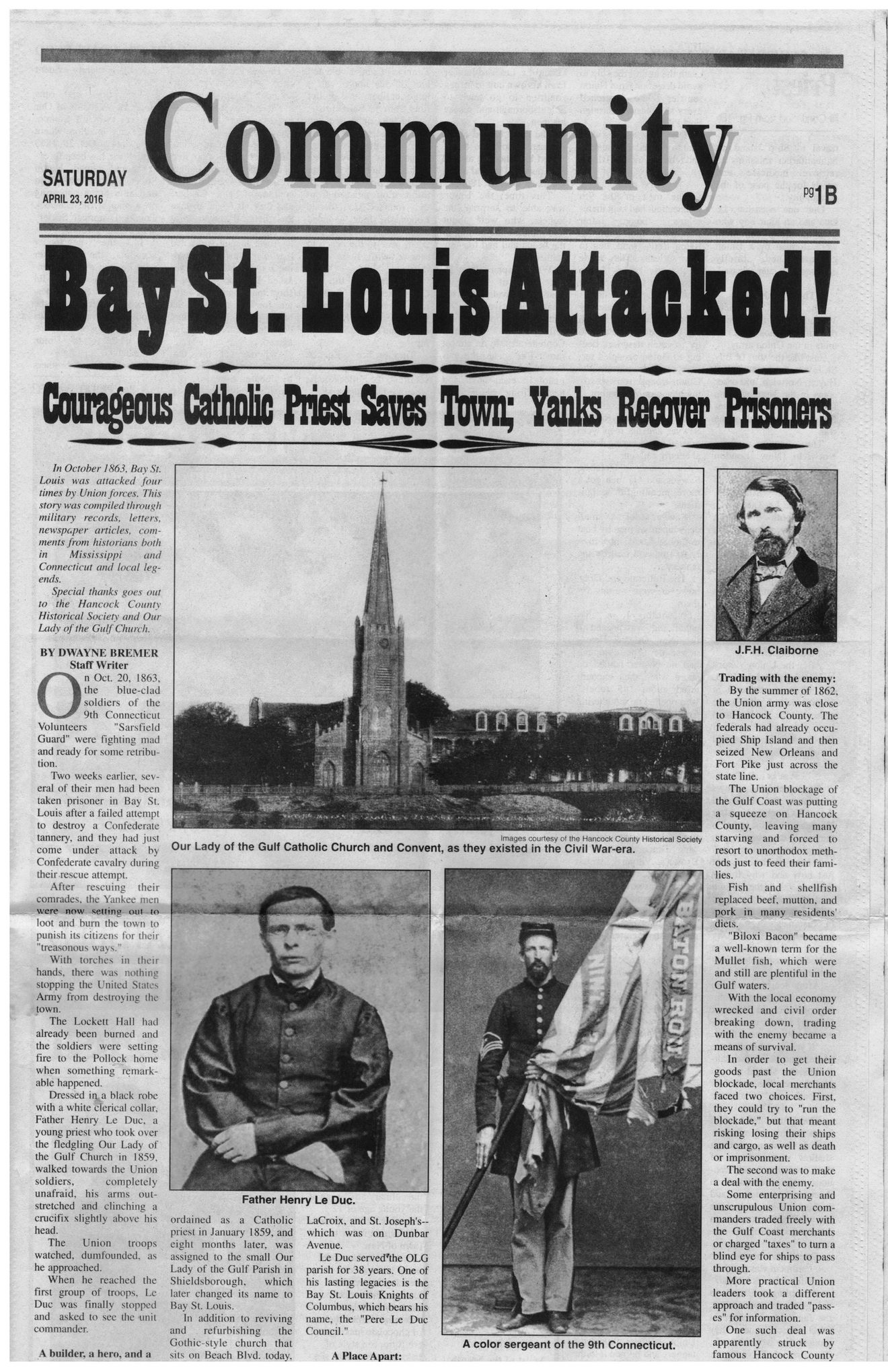This text was obtained via automated optical character recognition.
It has not been edited and may therefore contain several errors.
... Community „ APRIL 23,2016 Bay St. Louis ittaokid! Courageous Catholic Priest Saves Town; Yanks Recover Prisoners In October 1863. Bay St. Louis was attacked four times by Union forces. This story was compiled through military records, letters, newspaper articles, comments from historians both in Mississippi and Connecticut and local legends. Special thanks goes out to the Hancock County Historical Society and Our Lady of the Gulf Church. BY DWAYNE BRKMKR Staff Writer On Oct. 20, 1863, the blue-clad soldiers of the 9th Connecticut Volunteers "Sarsfield Guard" were fighting mad and ready for some retribution. Two weeks earlier, several of their men had been taken prisoner in Bay St. Louis after a failed attempt to destroy a Confederate tannery, and they had just come under attack by Confederate cavalry during their rescue attempt. After rescuing their comrades, the Yankee men were now setting out to loot and burn the town to punish its citizens for their "treasonous ways. With torches in their hands, there was nothing stopping the United Slates Army from destroying the town. The Lockett Hall had already been burned and the soldiers were setting fire to the Pollock home when something remarkable happened. Dressed in a black robe with a white clerical collar. Father Henry Le Due. a young priest who took over the fledgling Our Lady of the Gulf Church in 18.59. walked towards the Union soldiers, completely unafraid, his arms outstretched and clinching a crucifix slightly above his head. The Union troops watched, dumfounded. as he approached. When he reached the First group of troops. Le Due was finally stopped and asked to see the unit commander. A builder, a hero, and a Images courtesy of the Hancock County Historical Society Our Lady of the Gulf Catholic Church and Convent, as they existed in the Civil War-era. Father Henry Le Due. ordained as a Catholic priest in January 1859, and eight months later, was assigned to the small Our Lady of the Gulf Parish in Shieldsborough. which later changed its name to Bay St. Louis. In addition to reviving and refurbishing the Gothic-style church that sits on Beach Blvd. today. LaCroix, and St. Joseph's-which was on Dunbar Avenue. Le Due servedrthe OLG parish for 38 years. One of his lasting legacies is the Bay St. Louis Knights of Columbus, which bears his name, the "Pere Le Due Council." A Place Apart: A color sergeant of the 9th Connecticut. J.F.H. Claiborne Trading with the enemy: By the summer of 1862. the Union army was close to Hancock County. The federals had already occupied Ship Island and then seized New Orleans and Fort Pike just across the state line. The Union blockage of the Gulf Coast was putting a squeeze on Hancock County, leaving many starving and forced to resort to unorthodox methods just to feed their families. Fish and shellfish replaced beef, mutton, and pork in many residents' diets. "Biloxi Bacon" became a well-known term for the Mullet fish, which were and still are plentiful in the Gulf waters. With the local economy wrecked and civil order breaking down, trading with the enemy became a means of survival. In order to get their goods past the Union blockade, local merchants faced two choices. First, they could try to "run the blockade," but that meant risking losing their ships and cargo, as well as death or imprisonment. The second was to make a deal with the enemy. Some enterprising and unscrupulous Union commanders traded freely with the Gulf Coast merchants or charged "taxes" to turn a blind eye for ships to pass through. More practical Union leaders took a different approach and traded "passes" for information. One such deal was apparently struck by famous Hancock County

Our Lady of the Gulf Church Document (168)